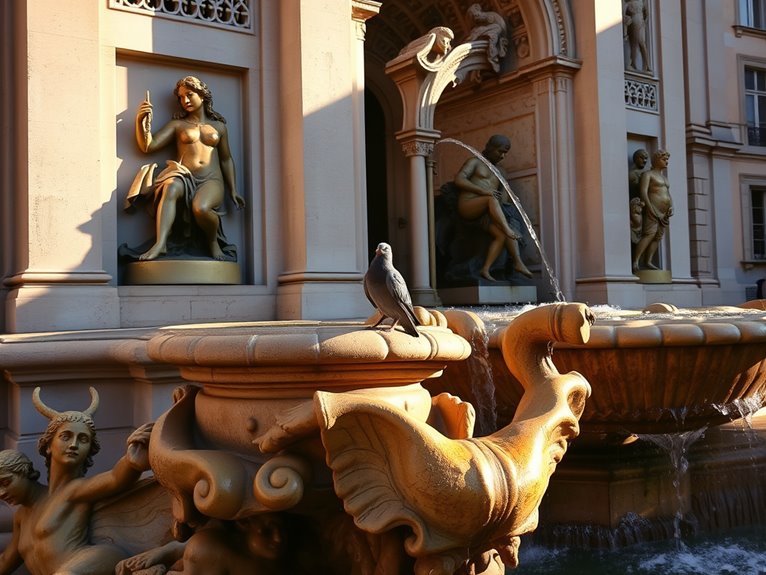
7 Historic Fountains in Paris With Fascinating Stories
Paris's historic fountains each tell an incredible story! From the Renaissance-era Fontaine des Innocents (1549) to the charitable Wallace Fountains that saved countless lives, these magnificent monuments blend art, power, and social change. I'm excited to share seven remarkable fountains, including Marie de Medici's garden masterpiece and the dramatic Fontaine Saint-Michel with its epic battle between good and evil. Get ready to discover the fascinating tales behind these architectural treasures that shaped Paris's identity.
The Revolutionary Waters of Fontaine Des Innocents
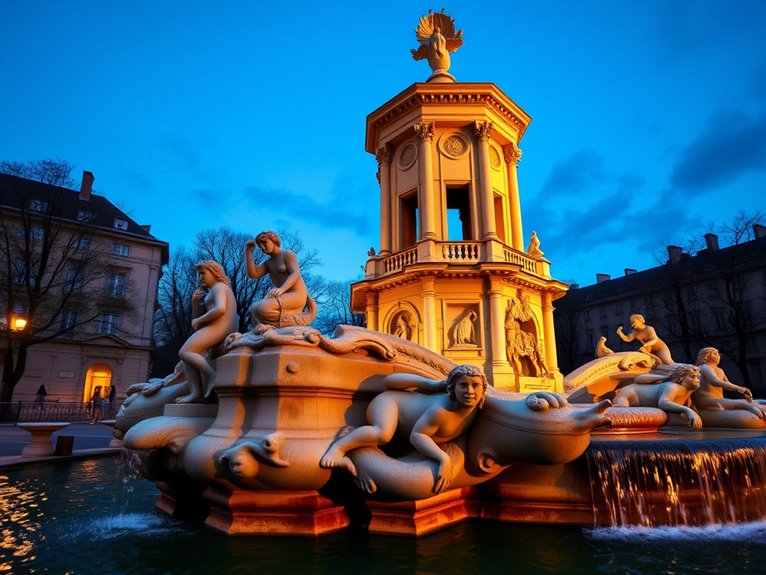
Standing proudly in the heart of Paris's 1st arrondissement, the Fontaine des Innocents represents one of the city's oldest and most historically significant fountains. Originally constructed in 1549 during the reign of Henry II, this Renaissance masterpiece has witnessed centuries of Parisian history, from royal processions to revolutionary upheavals, while maintaining its status as a remarkable example of French architectural heritage.
What makes this fountain particularly fascinating is its evolution from a wall fountain to a free-standing monument, reflecting the changing face of Paris itself. Designed by architect Pierre Lescot and adorned with sculptures by Jean Goujon, the fountain's transformation during Haussmann's renovation of Paris in the 1850s turned it from a practical water source into a celebrated artistic landmark that continues to captivate visitors and locals alike.
Quick Facts:
- Best visiting hours: 24/7 access, best lighting 10 AM – 2 PM
- Photography tips: Early morning for fewer tourists
- Location: Place Joachim-du-Bellay, 1st arrondissement
- Metro access: Les Halles (lines 4, 7, 11, 14)
- Surrounding area: Shopping district and cafés
- Historical significance: Oldest preserved fountain in Paris
The Architectural Marvel:
The fountain's distinctive design features elegant Nymphs carved in bas-relief, representing water deities that seem to float gracefully along the monument's surface. The structure stands 12.5 meters high, crafted in fine limestone, and displays an exceptional example of French Renaissance sculpture. Its current location in Place Joachim-du-Bellay places it at the heart of a vibrant pedestrian zone, though few visitors realize that the fountain was originally situated against the wall of the Saints-Innocents Cemetery.
Historical Evolution:
Originally a three-sided wall fountain, the structure was dismantled and reconstructed as a four-sided pavilion during the cemetery's demolition in 1786. This transformation included the addition of new sculptural elements to complete the fourth side, carefully crafted to match Goujon's original work. The fountain's water system has been modernized several times, most recently in 2019, ensuring that its streams continue to flow as they have for centuries.
Pro Tips:
The most rewarding way to experience the Fontaine des Innocents is to visit during the golden hour, just before sunset, when the dying light creates dramatic shadows across the sculpted figures. Consider bringing a sketchbook, as the fountain's intricate details have inspired artists for generations. The surrounding square often hosts street performers and local artists, making it an ideal spot to pause and absorb the atmosphere of contemporary Parisian life against this historic backdrop.
Practical Advice:
While the fountain is freely accessible, visitors should be aware that the surrounding area can become quite crowded during peak shopping hours, particularly on weekends. For the best experience, combine your visit with exploration of the nearby Forum des Halles and Rue Montorgueil, one of Paris's most beloved market streets. Photography enthusiasts should note that while tripods are permitted, commercial photography requires prior authorization from the city authorities.
Medici Fountain: A Garden of Royal Intrigue
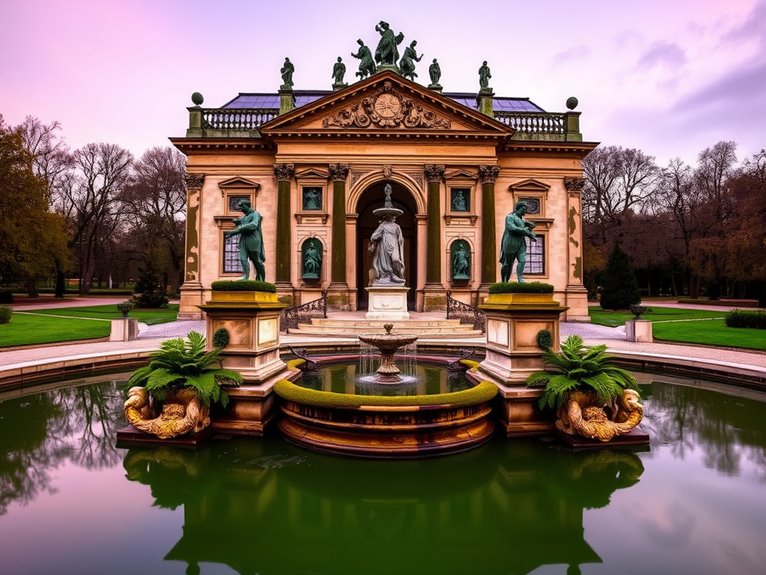
Nestled within the Luxembourg Gardens, the Medici Fountain stands as one of Paris's most enchanting Renaissance-style fountains, commissioned in 1630 by Marie de Medici, widow of King Henry IV. This architectural masterpiece was designed to evoke the grottos of her native Florence, serving as both a stunning decorative element and a peaceful retreat from the bustle of 17th-century Paris.
The fountain's rich history intertwines with tales of royal power, artistic excellence, and romantic intrigue. Its central sculptural group, added in 1864 during the fountain's restoration, depicts Polyphemus discovering Acis and Galatea, bringing Greek mythology to life amid the serene garden setting. Today, visitors from around the world are drawn to its magnificent carved facade, tranquil reflecting pool, and the mysterious atmosphere created by its shadowy grotto.
Quick Facts:
- Best visiting hours: Early morning (8-10 AM) or late afternoon (4-6 PM)
- Admission: Free with Luxembourg Gardens entry
- Photography tips: Morning light best for capturing reflections
- Opening hours: Same as Luxembourg Gardens (7:30 AM – sunset)
- Best season: Spring through fall
- Accessibility: Wheelchair accessible via garden paths
The Fountain Structure:
The fountain's architecture combines Italian and French design elements, featuring a central niche flanked by Tuscan pillars and topped with the Medici coat of arms. The 50-meter-long reflecting pool creates perfect mirror images of the surrounding trees and statuary. Insider tip: Look for the hidden mascarons (decorative faces) in the upper corners – each has a unique expression and was modeled after actual 17th-century courtiers.
The Sculptural Group:
The central sculpture by Auguste Ottin depicts the dramatic moment of discovery in the mythological love triangle. The massive figure of Polyphemus looms above the lovers Acis and Galatea, carved from gleaming white marble. Insider tip: Visit during the "golden hour" before sunset when the lighting creates dramatic shadows that enhance the sculptural details.
The Garden Setting:
The fountain is strategically positioned along a tree-lined alley, creating a natural frame that draws visitors toward its peaceful waters. The surrounding plantings are carefully maintained to reflect the original 17th-century design aesthetic. Insider tip: Hidden benches on either side of the fountain offer secluded spots for contemplation, especially during busy tourist seasons.
Pro Tips:
For the most magical experience, visit the Medici Fountain during light rainfall when fewer tourists are present and the water features take on an ethereal quality. Photographers should bring tripods for early morning shots when the fountain's pool is most reflective and the morning mist creates atmospheric effects. Consider visiting during the shoulder seasons (April-May or September-October) when the gardens are less crowded but the weather remains pleasant.
Practical Advice:
The fountain undergoes regular maintenance, typically scheduled for early weekday mornings. Check the Luxembourg Gardens website for any temporary closures or restoration work before visiting. Bring a small sketchpad or camera, as the fountain is a popular subject for artists and photographers, but be mindful of others trying to capture their own perfect shot. During summer months, the area around the fountain can become quite warm, so carrying water and finding shade nearby is recommended.
Fontaine Saint-Michel: Guardian of the Latin Quarter
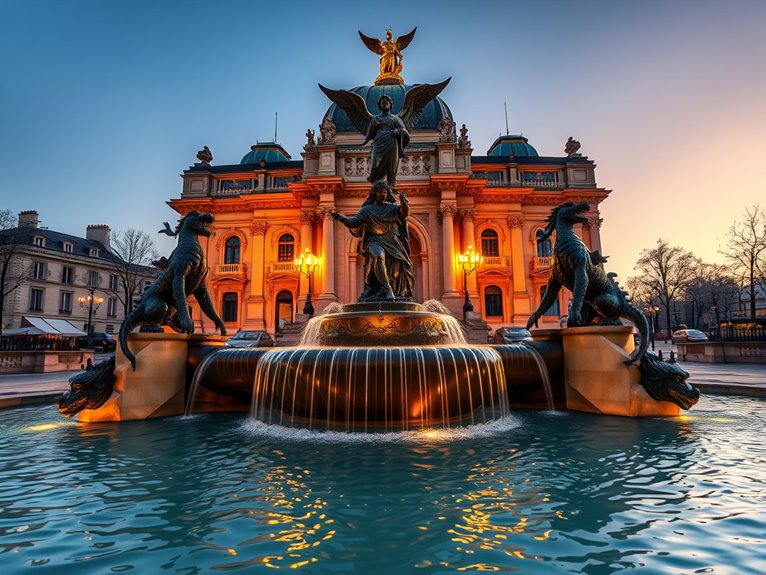
Standing majestically at the heart of Place Saint-Michel since 1860, the Fontaine Saint-Michel represents one of Paris's most dramatic Second Empire monuments. This monumental fountain, commissioned during Baron Haussmann's renovation of Paris, serves as both a stunning architectural masterpiece and a symbolic gateway to the Latin Quarter, where it has witnessed countless historical moments and continues to be a popular meeting point for locals and visitors alike.
The fountain's striking design by architect Gabriel Davioud features a dramatic neo-classical composition dominated by the bronze statue of Saint Michael vanquishing the devil, created by Francisque-Joseph Duret. Flanked by red marble columns and adorned with bronze dragons spouting water, the fountain exemplifies the grandiose architectural vision of Napoleon III's Paris, while its location at the intersection of Boulevard Saint-Michel and Saint-Germain makes it an unmistakable landmark in the city's landscape.
Quick Facts:
- Best viewing times: Early morning or evening for ideal lighting
- Photography tips: Best angles from the café terraces opposite
- Access: 24/7, free viewing
- Metro: Saint-Michel (Line 4)
- Illumination hours: Dusk until 1 AM
- Surrounding area activity peak: 11 AM – 8 PM
The fountain's architectural composition measures 26 meters high and 15 meters wide, making it one of Paris's largest wall fountains. The central group depicts Saint Michael, sword raised, standing over the fallen Lucifer, while four classical figures representing the cardinal virtues (Prudence, Justice, Force, and Temperance) watch from their niches. The fountain's water features operate daily, creating a pleasant ambient sound that helps mask the busy traffic of the intersection.
Location: The fountain forms the centerpiece of Place Saint-Michel in the 6th arrondissement, marking the border between the 5th and 6th arrondissements. While many visitors photograph the fountain from directly in front, the best views are actually from the slight elevation of the café terraces across the square, where the full scale and dramatic details of the composition become apparent.
Insider Tip: Visit during the first week of December when the fountain occasionally sports special holiday illumination that highlights the bronze figures in an ethereal blue light – a spectacle rarely mentioned in traditional guidebooks.
Pro Tips:
The ideal time to photograph the fountain is during the "blue hour" just after sunset, when the artificial lighting creates a dramatic contrast with the darkening sky. For the best experience without crowds, visit early morning (before 8 AM) when the square is quiet and the morning light casts interesting shadows across the sculptural details. Consider combining your visit with a morning coffee at one of the historic cafés facing the fountain.
Practical Advice:
When visiting the Fontaine Saint-Michel, be aware that the square can become quite crowded, particularly during peak tourist seasons. The area immediately around the fountain doesn't offer much seating, but numerous cafés and restaurants in the vicinity provide excellent vantage points. Keep your belongings secure, as the square's popularity with tourists can attract pickpockets, especially during busy periods.
Wallace Fountains: Lifeline of the Poor
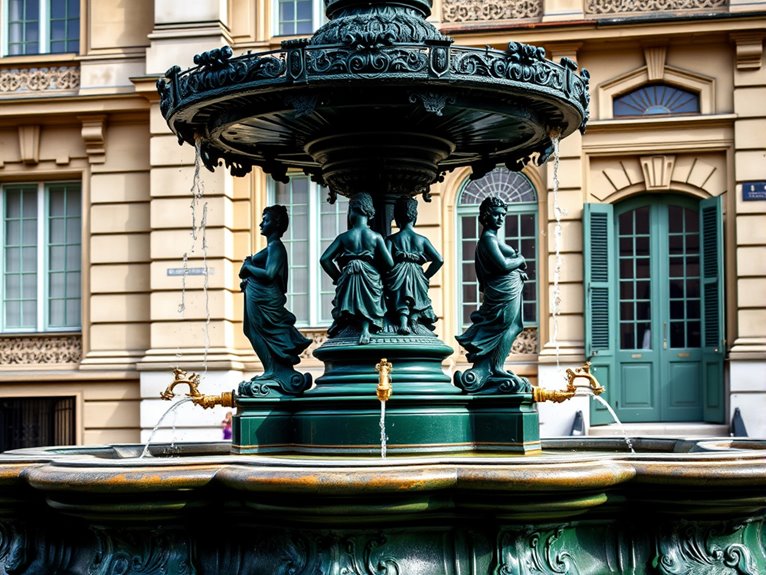
The iconic dark-green Wallace fountains have been quenching Parisian thirsts since 1872, standing as silent sentinels of public service and social reform. These distinctive cast-iron structures, designed by Charles-Auguste Lebourg, were philanthropist Richard Wallace's response to the destruction of Paris's water system during the Franco-Prussian War, providing free drinking water to the city's poorest residents when clean water was a luxury.
Today, roughly 100 of these historic fountains remain operational throughout Paris, continuing their original mission while becoming beloved symbols of the city's commitment to public welfare. The fountains represent a flawless marriage of functionality and artistic design, with their four caryatid figures representing kindness, simplicity, charity, and sobriety, making them both practical water sources and architectural treasures.
Quick Facts:
- Operating Season: March 15 to November 15 (to prevent freezing)
- Cost: Free
- Water Quality: Tested daily, perfectly safe to drink
- Height: 2.71 meters (8.9 feet)
- Weight: 610 kg (1,345 pounds)
- Available: 24/7 during operating season
- Photography: Best at early morning or golden hour
- Location: Throughout Paris, concentrated in historic districts
Large Model Wallace Fountains:
These fountains feature four female figures supporting a dome, with water trickling from the center. Found in prominent locations like the Champs-Élysées and Luxembourg Gardens, they serve as both functional water sources and popular photo opportunities. The most photographed example stands at Place Saint-Michel, where the fountain's green patina contrasts beautifully with the square's architecture.
Small Model Wallace Fountains:
A simplified version without the caryatids, these fountains are more numerous and typically located in residential areas. While less ornate, they maintain the same water quality and are often less crowded. An excellent example can be found in the Marais district, near Place des Vosges.
Applied Style Fountains:
Some Wallace fountains are mounted directly onto walls, particularly in narrow streets. These variations maintain the distinctive green color and water quality while taking up minimal space. A notable example exists in Montmartre, perfectly positioned for refreshment during the climb to Sacré-Cœur.
Pro Tips:
The fountains run continuously during operating hours, but water pressure is typically strongest in the morning before peak usage. Bring a reusable water bottle with a wide mouth, as the water stream arcs outward by design. For the best photos, visit during early morning hours when the fountains aren't being actively used and the light is ideal for capturing their intricate details.
Practical Advice:
Map out fountain locations along your planned walking routes before exploring the city. The Paris water authority (Eau de Paris) maintains an interactive map showing all functioning Wallace fountains. Remember that while the water is safe to drink, the exterior of the spouts should not be touched directly. Consider bringing a collapsible water bottle that can be easily stored when not in use, as you're never more than a few blocks from the next fountain during your Paris adventures.
Fontaine Du Châtelet: Theatre of Waters
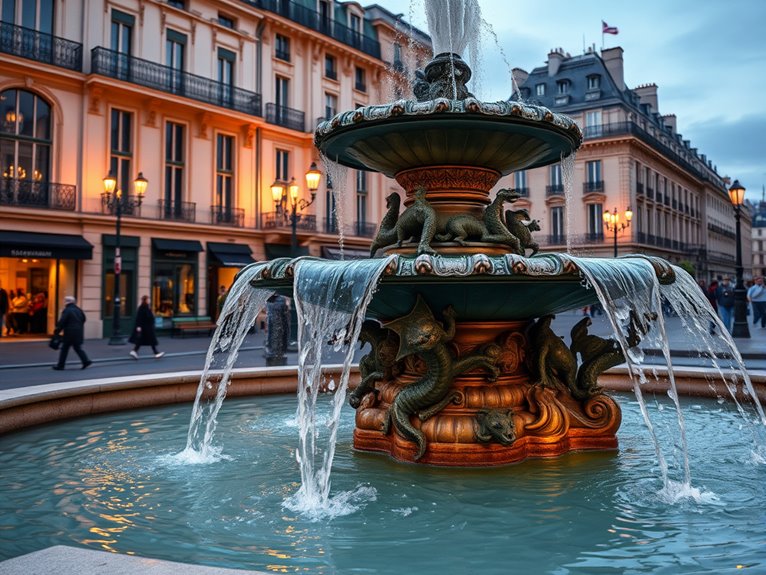
The Fontaine du Châtelet stands as one of Paris's most dramatic and historically significant water features, marking the spot where a medieval fortress once controlled access to the city's northern entrance. This magnificent fountain, constructed in 1808 during Napoleon's reign, represents both architectural grandeur and engineering innovation of its time, combining classical elements with symbolic representations of victory and abundance.
Located in Place du Châtelet, between the Seine's right bank and the Théâtre du Châtelet, this Egyptian-inspired monument rises as a celebration of Napoleon's Egyptian campaign victories. The fountain's design, crafted by architect François-Jean Bralle, features a central column adorned with palm leaves, while water cascades from bronze sphinxes into a circular basin, creating a mesmerizing display of aquatic artistry.
Quick Facts:
- Best viewing times: Early morning or sunset for ideal photography
- Access: 24/7, free public viewing
- Photography tips: Best angles from the theater side, morning light preferred
- Metro access: Châtelet station (Lines 1, 4, 7, 11, 14)
- Illumination hours: Dusk until midnight
- Maintenance periods: Usually spring and fall
The Palm Column
Rising 52 feet high, the column's palm leaf motif represents victory and peace, while its golden winged figure at the top, known as "Victory," holds a laurel wreath. The base features four sphinxes that spout water into the basin below, each representing different aspects of abundance and prosperity. This architectural marvel serves as both a monument and a functioning fountain, maintaining its original hydraulic system with some modern modifications.
The Sphinxes
The four bronze sphinxes, designed by Gabriel-Jean-Antoine Davioud, are particularly remarkable for their intricate detailing and symbolic significance. Each sphinx produces a steady stream of water that creates a gentle musical sound as it hits the basin. An often-overlooked detail: the sphinxes' faces were modeled after prominent Parisian women of the early 19th century.
The Basin
The circular basin, measuring 20 feet in diameter, features detailed stonework and serves as a reflecting pool that mirrors the surrounding architecture. The basin's design includes hidden drainage systems that have kept the fountain functioning efficiently for over two centuries, a demonstration of early 19th-century engineering expertise.
Pro Tips:
The fountain's most spectacular views come during the golden hour, just before sunset, when the setting sun illuminates the golden Victory statue and creates dramatic shadows across the sphinxes. For photographers, positioning yourself at the corner of Rue Saint-Denis provides an ideal angle that captures both the fountain and the historic theater backdrop. Visit during spring or fall when the water flow is typically strongest and the tourist crowds are thinner.
Practical Advice:
While visiting the Fontaine du Châtelet, be aware that the surrounding area can be quite busy due to its proximity to major theaters and metro stations. The best time for contemplative viewing is early morning before 9:00 AM. The square offers several cafes where visitors can sit and admire the fountain while enjoying typical Parisian refreshments. During summer months, street performers often gather around the fountain, adding to the lively atmosphere but potentially affecting photo opportunities.
Fontaine Des Quatre-Saisons: Madame De Pompadour's Legacy
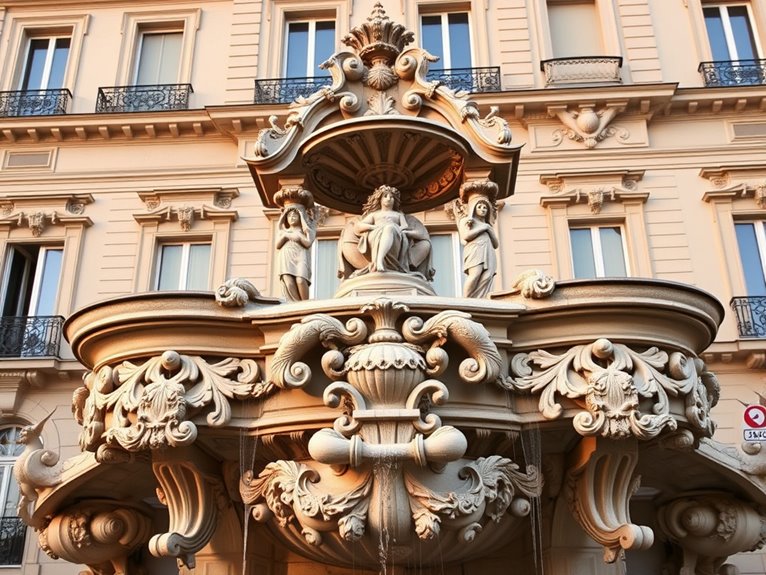
The Fontaine des Quatre-Saisons stands as one of Paris's most elegant 18th-century fountains, commissioned by the city in 1739 and completed in 1745. Located in the fashionable Rue de Grenelle in the 7th arrondissement, this masterpiece of French Rococo architecture bears the unmistakable influence of Madame de Pompadour, King Louis XV's influential mistress who shaped much of the artistic direction of her era.
This monumental fountain, designed by Edmé Bouchardon, represents more than just a water source – it's a reflection of the architectural grandeur of 18th-century Paris and the power of artistic patronage. The fountain's elaborate sculptural program, featuring allegorical figures of the four seasons and Paris herself, offers visitors a glimpse into the sophisticated symbolism and artistic achievements of the French Rococo period.
Quick Facts:
- Location: 57-59 Rue de Grenelle, 7th arrondissement
- Best viewing times: Early morning or late afternoon for ideal lighting
- Photography tips: Wide-angle lens recommended for full facade capture
- Access: Free, public viewing 24/7
- Nearest Metro: Rue du Bac (Line 12)
- Conservation status: Protected historical monument since 1862
The Fountain's Architecture:
The fountain's imposing facade spans 40 feet high and features a central niche flanked by two wings. The main sculptural group depicts the City of Paris as a seated female figure, surrounded by the Seine and Marne rivers represented as reclining male figures. The four seasons are represented by female figures in relief panels, each characterized by distinct attributes and seasonal symbols. A hidden feature often missed by visitors is the original water spouts, which are still visible though no longer functional.
The Historical Context:
Built during a period when Paris was modernizing its water distribution system, the fountain served both practical and decorative purposes. Madame de Pompadour's influence can be seen in the choice of Bouchardon as the sculptor and the overall refined aesthetic of the piece. An insider tip: look for the small sculptural details near the base that include elements of Pompadour's personal coat of arms, subtly incorporated into the design.
Pro Tips:
The best time to photograph the fountain is during the "golden hour" just before sunset, when the low-angle light brings out the subtle details in the sculpture work. Visit on a cloudy day for even lighting that reveals the intricate carving details without harsh shadows. For the best viewing experience, start at the far end of the street and approach slowly to appreciate how the fountain's scale and details gradually reveal themselves.
Practical Advice:
While the fountain is freely accessible, the narrow sidewalk can make viewing challenging during busy times. Consider visiting early on weekend mornings when traffic is lighter. The surrounding area hosts several cafes perfect for taking a break while admiring the fountain, though be aware that many are closed on Sundays. Photography is permitted, but using a tripod may require special permission from local authorities due to sidewalk space constraints.
The Stravinsky Fountain: Modern Art Meets Medieval History
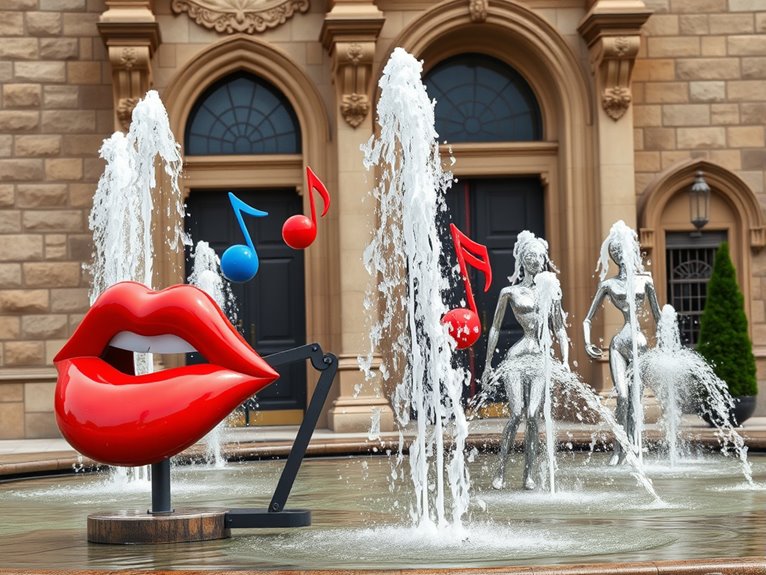
Located in Place Igor Stravinsky, adjacent to the Centre Pompidou, the Stravinsky Fountain stands as one of Paris's most playful and distinctive modern landmarks. Created in 1983 by artists Jean Tinguely and Niki de Saint Phalle, this kinetic fountain features 16 whimsical sculptures that dance and spray water in a delightful celebration of composer Igor Stravinsky's most famous works.
This vibrant installation represents a fascinating contrast to its historic surroundings, sitting in the heart of the Marais district where medieval architecture meets contemporary art. The fountain's mechanical sculptures, painted in bold primary colors, create a striking juxtaposition against the Gothic architecture of the nearby Church of Saint-Merri and the ultra-modern facade of the Centre Pompidou.
Quick Facts:
- Best viewing times: 10 AM – 7 PM (fountain operates March-October)
- No entrance fee
- Photography permitted (best light in late afternoon)
- Accessible year-round, though water features operate seasonally
- Located in the 4th arrondissement
- Adjacent to multiple cafes and restaurants
- Wheelchair accessible
- Close to multiple metro stations (Rambuteau, Hôtel de Ville)
The Fountain's Key Features:
The 16 mechanical sculptures represent different aspects of Stravinsky's music, including the "Firebird" (a bright red bird), the "Love Birds" (two intertwined figures), and the "Fox" (a playful mechanical creature). Each piece moves independently, creating a mesmerizing mechanical ballet that perfectly complements the surrounding cultural quarter. The shallow pool spans 580 square meters and features black asphalt bottom designed to enhance the visibility of the colorful sculptures.
Insider Tip: While most visitors photograph the fountain from ground level, the terrace of the Centre Pompidou offers a stunning aerial view of the entire installation, revealing patterns in the sculpture placement that aren't visible from below.
Pro Tips:
Visit during the golden hour (approximately one hour before sunset) when the interplay of light and water creates spectacular photo opportunities. The fountain is less crowded during weekday mornings, allowing for unobstructed views and peaceful contemplation. Consider visiting during different seasons to experience how the changing light affects the sculptures' appearances and shadows.
Practical Advice:
The fountain area can become quite crowded during peak tourist season (June-August). For the best experience, combine your visit with the Centre Pompidou's late-night openings on Thursdays, when the evening light creates dramatic reflections on the water and the crowds are thinner. Keep in mind that the water features may be turned off during winter months or for maintenance, so check local listings if the water display is essential to your visit.
